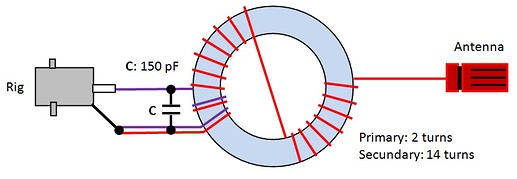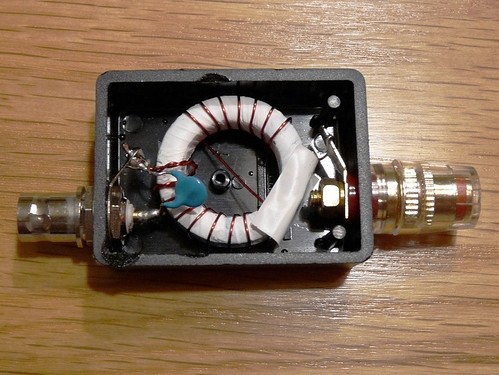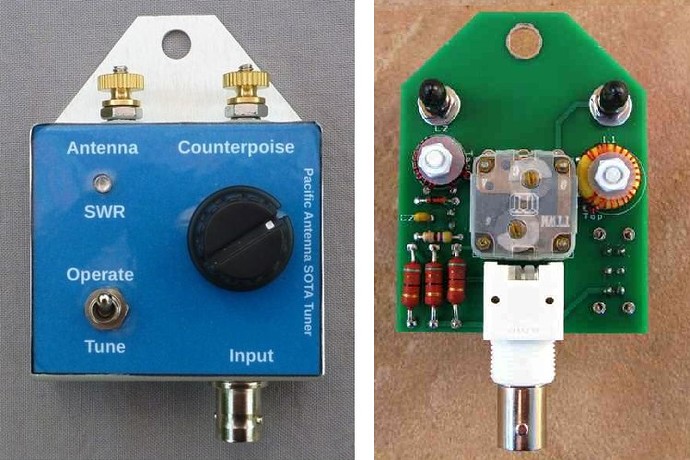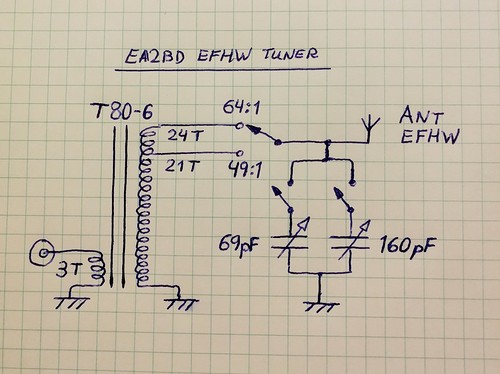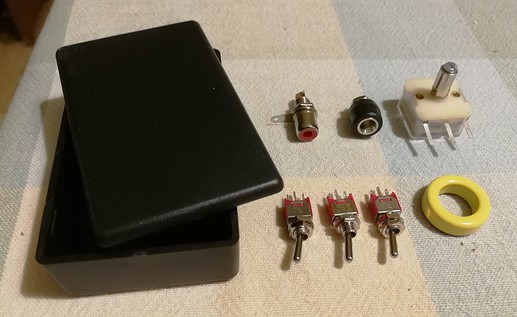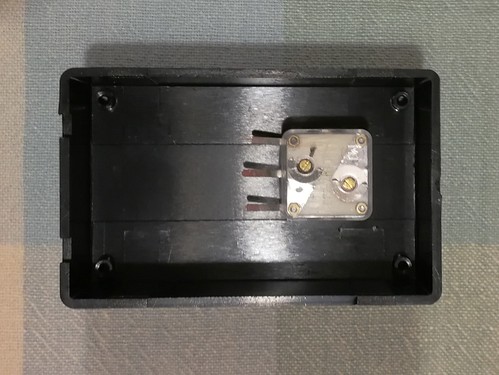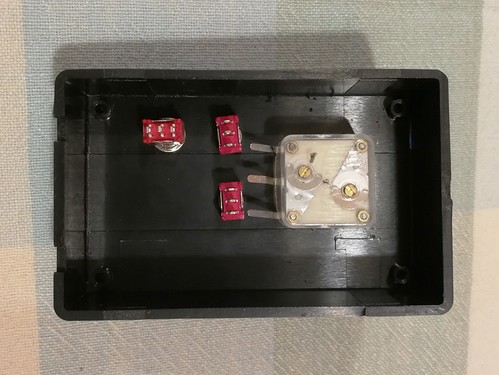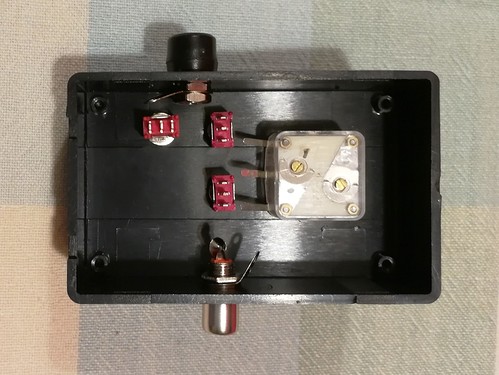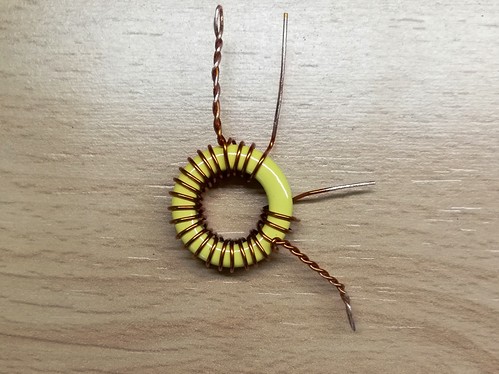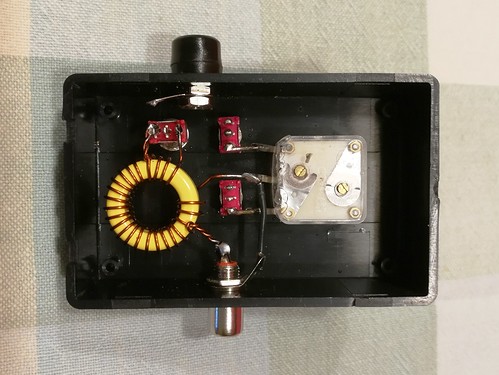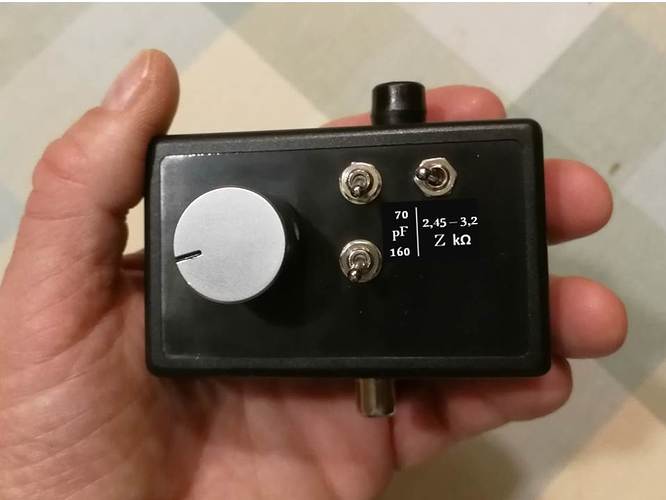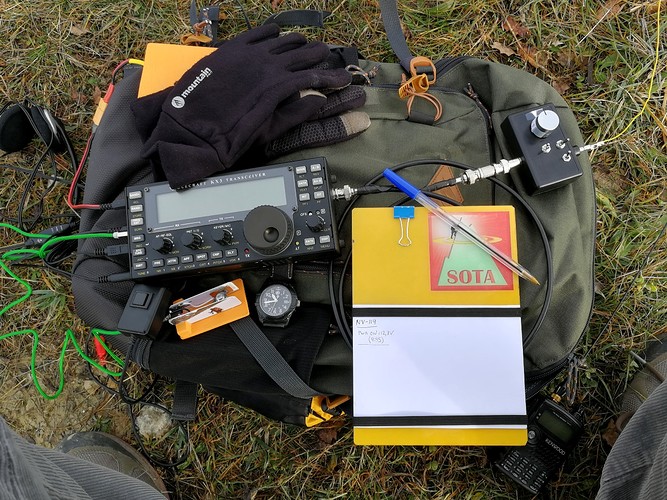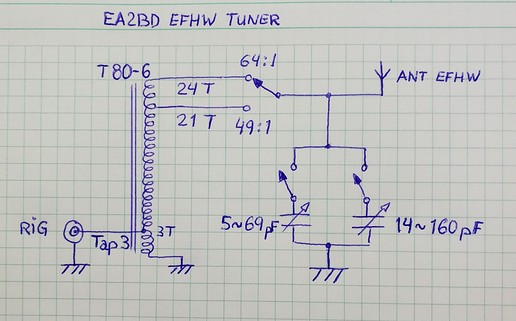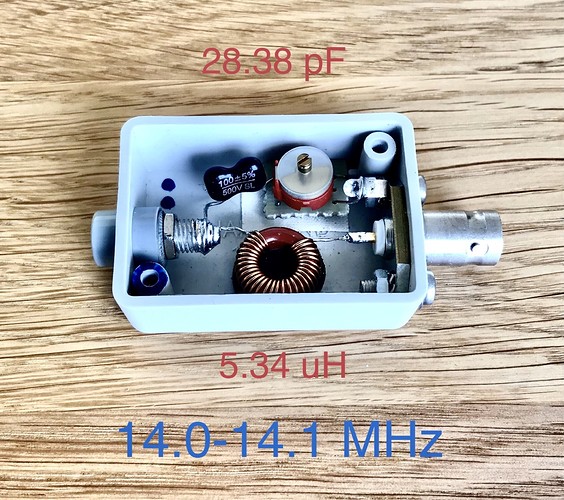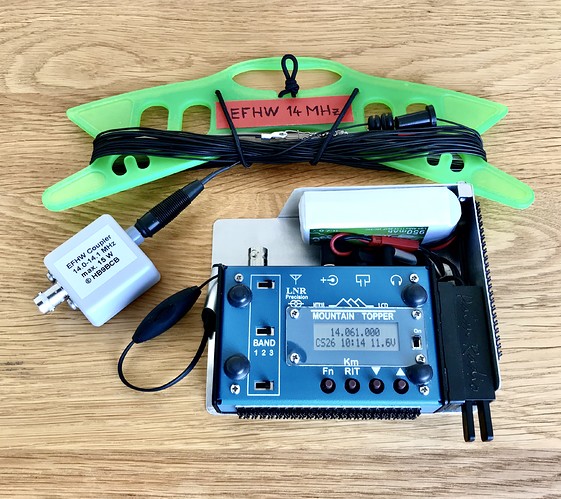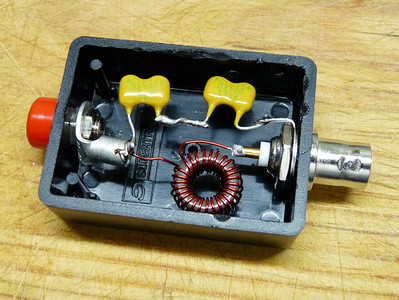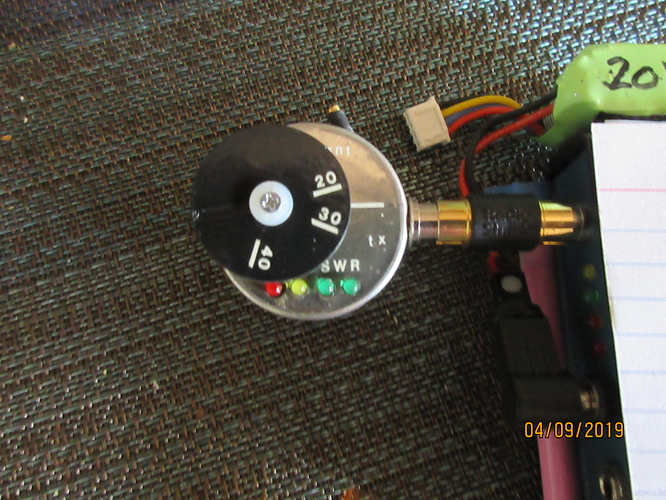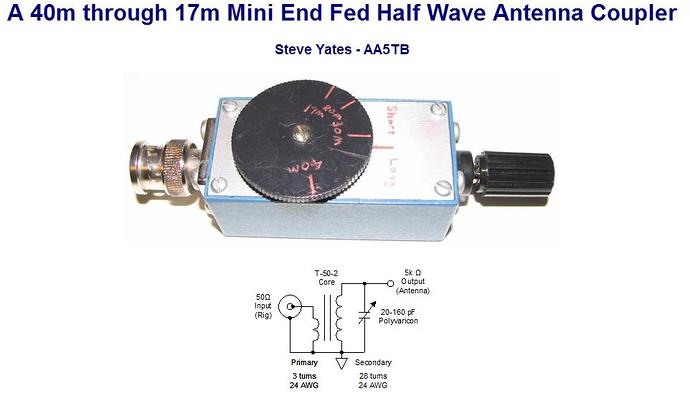Background
When I started in SOTA I used for some time different antennas: resonant quarter wave verticals, non resonant random length verticals, dipoles, doublets with tuner, and finally the EFHW (resonant end fed half wave).
The EFHW was the better choice after trying all these different antennas for several reasons:
-
Feeding the antenna at the lower end reduced the required run of coaxial cable when compared to other antennas feed at the centre or high in the appex of the pole.
-
Multibanding the EFHW antenna was easy by placing either manual links or LC traps.
-
It was easy to deploy it inverted V, inverted L, or straight at a lower height in difficult summits.
To connect the EFHW to your rig you need a transformer because this antenna is a high impedance, with a value of around 3000 ohms.
I built an easy to do wideband transformer using a material 43 ferrite ring core. This is a common solution used by many people. The feeder I used is this design, with a FT 114-43:
I have been using this setup for many years with satisfaction. Performance was more or less repeatable but in some summits I experienced troubles with increased SWR level compared to what I had in some other summits. I worked many stations and some DX at the right time, as propagation allowed.
By reading a bit more on the subject, I have seen that this wideband and miraculous transformer has some losses that contribute to be so versatile. These losses reduce SWR and the rig is happy at the expense of losing some radiation.
I have experienced disturbing high values of SWR when QSYing from CW portion of one band to the SSB portion. It makes sense; you trim the antenna wire length to be optimal to either CW or SSB, and therefore, if you go up the band changing frequency, there will be some SWR variation.
For that reason I was motivated to consider a different way of feedind my EFHW.
What could I do to solve my SWR issues and improve performance?
An alternative feeder: the EFHW tuner
Instead of using the wideband transformer as shown above, I rode about monoband transformers. It is easy to build a feeder using iron powder toroids plus adding a capacitor in parallel to have a LC circuit. The combination of inductance and the capacitor determines the resonant frequency.
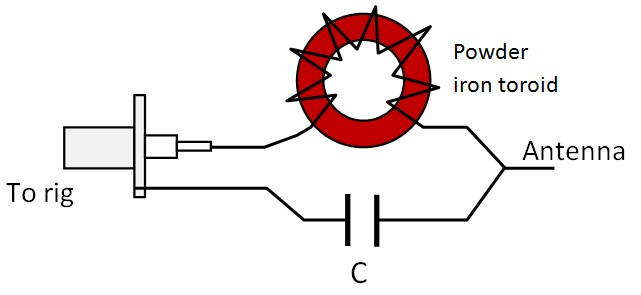
Being my most used bands for a SOTA activation 40 – 30 – 20 meters I decided to build a mini tuner with a variable capacitor that would resonate in all these bands, instead of using a fixed cap that would be valid for a single band.
This design is not mine; they are homebrewed designs on internet as well as some parts available in the market, like the Pacific antenna tuner (QRP Kits) or the one made by QRP Guys:
Why should I care to build my own version then?
EA2BD EFHW tuner
Okay, I could buy one of these kits, but I thought I would rather prefer to do my own version with these features:
-
I would use powder iron material 6, which is appropriate for 5 to 30 MHz resonant circuits. Some people use material 2 but it seems to be less appropriate if you intend using higher bands, say between 7 up to 28 MHz.
-
Most tuners have a fixed ratio of 49:1 or 64:1. Instead I would like to add flexibility by making my tuner had the two ratios selectable.
-
Most of the existing tuners use a polyvaricon with a range of about 15 to 250 pF. I would prefer to have the choice of reducing the range of my capacitor for some bands so that the tuning process would be less touchy.
-
I would like a tuner that could work with a max power of 15 watt.
-
I will get rid of putting a SWR led bridge, as I will read SWR level in the rig display.
With these constraints I contacted George, KX0R, one of the best End fed antennas guru. Based upon his experiments on the field he has developed his own versatile tuner, that can handle variable situation and deals with both low or high impedance in the antenna.
His design is here. (opens new window)
My goal was simpler, because I would always use a resonant half wave and therefore the expected impedance would always be high. That would make my design simpler, but I checked with him the doubts I had.
He was very supportive, replied to all my questions and gave me valuable advises on how to assemble my model; thanks a lot George!
This is how my design looks like:
As you can see, I have added two switches in the two gang capacitor and therefore I can select between range 1: 5 - 69 pF, range 2: 14 - 160 pf, or range 3: 19 - 229 pF.
In the other hand, I intend to build the transformer based on material 6 with 3 turns for Primary, then 21 turns Secondary, to have a 49:1 ratio, for a 2450 ohm impedance in the antenna side, and add 3 more turns to reach 24 turns, that is for 64:1 ratio, or 3200 ohm.
Having these two ratios available I can play on the field and have better control of the antenna impedance in its specific location and therefore compensate ground effect variation and its influence on impedance.
It would be great to add some more taps and create other ratios, but this would make the tuning process much more complicated and long. Having these two basic ratios will probably cover most cases. We’ll see later if these ranges are all right.
Building the tuner
I checked in my junk box and found many of the required components. I just had to buy a small plastic box and aT80-6 core (I choose that diameter to keep the core cool for low power). The rest was available. Let’s see the build up process step by step.
1.) Drill hole for the polyvaricon and fit in the box. Be carefull when tightening the screws onto the body shaft, if the screws go too deep they get inside the capacitor and can deform and damage the inner plates. I added washers to avoid this trouble. Tighten with care.
2.) Drill and install the three switches for the capacitor and the toroid.
3.) Drill and install the input RCA connector and the outlet banana connector.
4.) Wind the toroid with 0,6mm ennameled wire (AWG #23), counting each time the wire passes inside the core. Make a tap at nr. 3, another tap at nr. 21 and end after 24 turns. Remove the ennamel in all taps and solder the ends.
5.) Install and solder the core according to scheme. Be quick when soldering to the ground lug of the polyvaricon, avoid excesive heating.
6.) Add wires between the switches and to the antenna connector to finish the assembly.
The tiny tuner is ready to test. It weights 58 gram (2,05 oz).
Bench tests
Prior to testing the tuner in a summit I connected a 3000 ohm resistor between the antenna connector and ground to simulate a EFHW antenna.
Then I connected it to the KX3 and reduced power to 1 watt, sent a carrier and rotated the capacitor wheel monitoring the SWR level. I saw a constant reduction of SWR and I soon got a dip at 1,3:1. It worked ok! Being the resistor 3 kohm I couldn’t expect SWR to be just 1:1 because of the existing rates in my tuner, set to 3200 or 2450 ohm. Test agreed with theory.
I compared the different setting of the switches and soon verified that it was a good idea to have a selectable end of range for the capacitor. Tuning process was smooth and precise, and it wasn’t tricky at all.
I checked if it worked in many HF bands and these are the results:
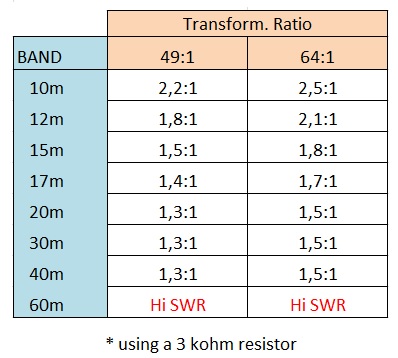
The tuner works best between 40m to 15m, but 12 and 10m are still useable.
It didn’t work on 60m because I would need more capacitance in that band. This could be solved by adding an extra capacitor in parallel.
Concerning the polyvaricon selector, I connect both switches for 40m, just the 160 pF section for 30m and only the 69 pF section for 20m and up.
The tuner works really well and it is easy to tune for low SWR.
Field test
I have perfomed two activation with the tuner and both times it worked equally well.
I place the tuner next the rig, over my backpack. In the past I used to put the feeder about 1 meter above ground but this tuner can be placed just over ground. I thought that placing it in the ground would change much more the impedance but so far I don’t see a large influence.
The settings are similar as the ones achieved with the resistor on bench. I normally obtain good values with the 49:1 ratio, but it’s also possible to use the 64:1 and results are similar although the capacitor is set in other position.
The good point in using the tuner is that I can qsy between CW and SSB in the same band and SWR after a retouch of the tuning wheel is perfect for both parts of the band. It takes a few seconds for achieving minimum SWR. A tuner with a single knob is very easy to use!
You can preset the position of the polyvaricon by ear, because turning the knob varies the background noise in the receiver and you can tune until the signals are louder; there you are close to the optimum setting. Then send a carrier and fine tune. Fast and easy.
I will need more activation to check the stability of the tuner but it looks very promising. My last activation ended with 73 qso, good reports, and a DX qso with ZL; things don’t go wrong.
Future development
I would like to measure and compare efficiency of this tuner versus the broadband transformer with material 43.
I don’t have a big laboratory equipment. I could estimate some value by performing Near field power measurements, or power in/power out on bench, I guess…
Is there an easy way to measure efficiency and insertion loss? This would require some study and investigation, but I think it’s not that easy.
In the end, it would probably be a tough work for what I can expect a 1 dB loss.
I guess I get such loss almost with any kind of feeder I use, and probably it’s going to be hardly noticeable by chasers on air to tell which one I’m using.
The real benefit of using my tuner is that it extends my operation protecting the rig and adds more qso in my log.
73 de Ignacio
Pd: if you want to read more about toroid material, check this other interesting thread here.
